MUSLIM RITUALS
Birth According to the Muslims, the first words that a child should hear are the words of God. Hence the Azaan is spoken into the new -born's right ear and the iqamat is spoken into his left ear. There are no specific rituals following the birth of a child. If there are, then they are dependant on the local customs and habits of the region. Smoke is used to clean the labour room. The child is first given the juice of palm dates chewed by any Muslim priest. This is applied on the upper jaw of the child. Only after this the child is allowed to feed on the mother's milk. On the seventh day following delivery the mother is bathed in warm water. The midwife is given clothes and money by the relatives.
Circumcision
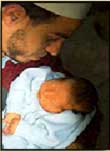
Marriage
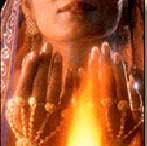
Talak or Divorce
According to Muslim personal law if a man and woman find it impossible to live together for any kind of reason then there is provision for them to separate. The talaq is to be given by saying, "I hereby give you talaq", and three times with a gap of one calendar month between each talaq. There is also a provision by which a woman can also divorce her husband. This is called Kullahi. After talaq, a woman has to observe iddat before she can remarry. Iddat is the probation period of three months and thirteen days during which a woman has to be confined to her house and observe purdah from all men. Her husband should pay her the nano - nafka or the money for her maintenance during that period. It includes the money for her clothes, food and housing.
Death

CHRISTIAN RITUALS
Birth
When a woman is about to deliver a baby , the priest of the congregation is called for and he prays for a safe delivery. There are no special rituals concerned with the birth of a child. Then after 40 days of cleansing the mother takes her newborn to the church for thanksgiving. There she gives offering to the Lord. Usually the first birthday of the child is celebrated elaborately with the parents arranging a special feast for the guests. All of them give gifts to the kid. And the child cuts a special birthday cake to be shared between the guests.
BAPTISM
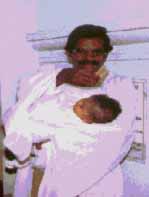
At Baptism, the child is relieved of this sin and he becomes a child of God and a member of the church. Baptism is done usually before the first birthday. The child is given white clothes, shoes and cap by his parents and relatives give him gifts. A feast is given to them and the priest , by the parents.
MARRIAGE
Engagement :
This is usually held at the brides' residence. It is more or less a family affair and only the close relatives attend the function.The priest starts the function with a prayer. Then the girl and the boy exchange garlands, the Bible and a ring as a mark of their engagement. The priest delivers a small sermon and a feast is given for the invitees. The girl and the boy are given time to talk and understand each other. On this day the date of marriage and other details are discussed between the groom's and the bride's side.
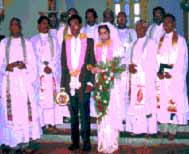
Marriages usually take place in the nearby churches. The marriage celebrations are influenced by local customs and practices and may vary according to the region. On the day of marriage, the groom's party arrives at the bride's residence and the bride's father welcomes them. He welcomes the groom with a garland and a golden chain. Then the groom's party is given breakfast. The groom's side then goes to the nearby church accompanied by music bands. The bride's party follows suit. At the church the head priest leads the boy and the girl to the altar. Small girls with flower baskets accompany the couple ,to sprinkle flowers over the couple. At the Altar, the priest prays for a happy life for the couple and then he blesses them. Texts from the holy Bible are read and he makes a short sermon. The father of the bride gives her hand to the groom. Then the groom ties a golden chain in the neck of the bride or slips a ring on the girl's hand. A choir usually accompanies the service with melodious songs blessing the couple. Then they get to the bride's residence for a sumptuous meal. The guests give gifts for the newly married couple. At night a reception would be arranged at the boy's place.
Death

HINDU RITUALS
Hinduism: is the religion of the majority of the population of India. The holy books of the religion namely the Vedas and the Upanishads clearly explain the rituals and their mystical contents. They also explain in detail the observance of sacrificial and purification rituals.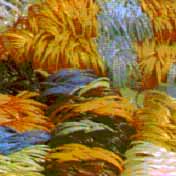
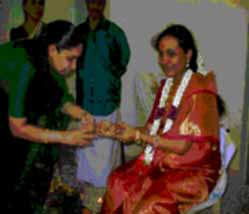
The bangles are removed only during delivery and given to the midwife at the birth of a child. Arti is performed. The mother of the girl presents her silk saries and gold and silver bangles. The invitees give gifts for the mother-to -be and they are given a feast.
Mottai Addithal (Tonsure)

Kaadukutthal (Ear -Piercing)
It is a very important event for the Hindus in India. According to Hindu belief, the piercing of a hole in the ear completes the shape of AUM , based on the shape of the ear. The baby is made to sit on his maternal uncle's lap during the ritual. A goldsmith is invited to do this and he is given clothes and money. This ritual is perofrmed for children of both the sexes.While the girls retain the holes for wearing studs, the boys gradually lose them.
Annaprasanam
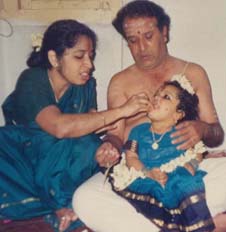
UPANAYANAMM
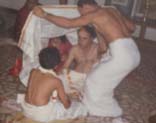
MARRIAGE
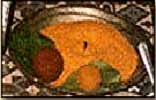
Mridangam
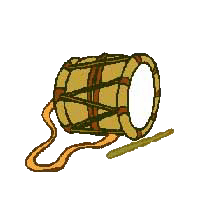
Kettimelam

Couple circling the sacred fire
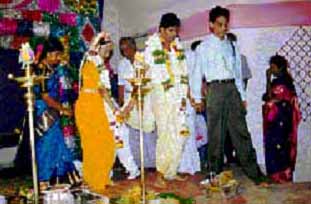
hen an elaborate lunch consisting of Vadai , payasam, rice varieties, papad and sweets are given to the guests by the bride's side. The couple is then taken to the groom's house where the members with banana, milk and sweets welcome them. There the couple is engaged in small petty games so as to tease each other. Then the groom's side arranges a reception with a good dinner accompanied by music concerts. After this, the bride's party leave her in the groom's house, where arrangements will be made for the first night ceremony.
Death
When a person dies, a lamp is lit and placed near the dead body. The body is placed in the north-south direction with the head towards the north. The eyes are closed and the feet are tied together. The eldest son is supposed to do the last rites. The body is bathed and is covered with new clothes. Then the members of the family apply oil on the forehead of the deceased. Then the body is decorated with flower garlands and is taken to the cremation ground. Usually the sons and other male members carry the dead. Women are not allowed to go to the ground. They bid farewell to the deceased at the home itself. At the cremation ground, the son applies ghee at seven important places in the body and also places coins on the forehead. Grains of rice and til are put into the mouth of the body. Wooden logs are placed over the body and ghee is sprinkled all over. The son goes round the body seven times with a pot of water and at last the pot is broken near the feet of the dead. Then as the priest chants the mantra, the son takes the Agni or fire and places it on the heart of the body.
Then on the 3rd or 5 th day day after cremation, the relatives visit the crematorium and pour milk over the place , so as to pacify the dead soul. Then a simple lunch is arranged for the members.
JAIN RITUALS
Priyodhbhav SanskarThis ritual takes place after the birth of a child. Ten days of cleansing or Sutak are observed after delivery. During this period no rituals are performed. But in the temple the priest recites mantras and receives offerings on behalf of the new-born.
Namkaran Sanskar
This is the naming ceremony. It is done on the eleventh, thirteenth or twenty-ninth day after the birth of a child. For Namkaran the name is selected from the 1008 Jinasahasranam for the boys and names of the girls are selected from famous women of the Puranas. The priest, chanting mantras declares the name and thenthe child is blessed.
Marriage
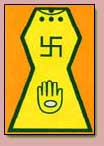
Laghana Lekhan This is the first of the nine rituals and it consists of fixing the date and time of marriage called Laghana Lekhan and is held at the bride's residence. The priest performs Puja and he determines the time of marriage. Then the Patrika bearing the time or Muhurta is sent to the groom's house with sweets.
Lagna Patrika Vachan
This is the reading of the Laghana Patrika at the groom's house by the priest.
Sagai
This is the engagement and is done at the groom's residence. The groom performs the Vinayakyantra pooja and then the bride's brother applies tilak and presents him gifts like gold chain, ring, clothes and sweets. The elders of the family bless the groom.
Mada Mandap
This ceremony is held a day or two before the marriage both at the groom's as well as the bride's place at an auspicious time.
Ghudhchadi
Before going to the bride's place, the groom is given a headgear, traditional to the Jains and relatives apply tilak on his fore- head. Then he visits a temple in a ceremonial horse.
Barati
This takes place on the bride's house on the arrival of the groom. The bride's brother welcomes the groom's party and applies tilak on the groom and gives him gifts.
Phere
This is the actual marriage ceremony. The groom and the bride are seated in a mandap. The groom and the bride take the seven vows and the girl sits to the left of the groom.
Kanyavaran
This is the presenting of the girl to the groom by the bride's parents. The father proclaims to the congregation that he has given his girl to the groom. The priest pours water on the hands of the groom and the bride, chanting mantras. Then the priest begins a havan.
Granthi Bandhan
After the havan, the couple is ritualistically tied; a corner of the pallu of the bride's sari is tied to the shawl of the groom. Mantras are recited and the couple circles the havan 4 times. The couple exchange garlands and then the elders bless them. Then a feast follows .After the ceremony is over, the bride is sent to the groom's house and alms are distributed to the poor in the Jain temples.
Death
The Jains cremate the dead as soon as possible. First the body is rubbed with a wet cloth. The corpse is then clothed and placed in a bier and covered with a kafan. The body is tied to the bier and taken to the crematorium. A suitable place without any living organisms like grass or insects is selected so as not to harm them. There a platform of wood is erected.
The body is taken from the bier and placed on the platform with logs of wood over it. Ghee, camphor and sandalwood powder are sprinkled all over the body and the eldest son of the deceased does the last rites.
The son goes round the pyre three times sprinkling water allover the body. Chanting the Namokar Mantra ,he lights up the pyre. Then after sometime they pour milk over the place. The remains are collected in bags and the place is thoroughly cleansed. The remains are not immersed in rivers as they can pollute the water. Instead they dig a hole in the earth and put the remains and sprinkle salt all over, so that it dissolves easily.
The Jains believe that the dead soul would be reborn immediately. So for them death is a festival or Mahotsav. Loud wailing and observing anniversaries are not part of the Jain Tradition.
SIKH RITUALS
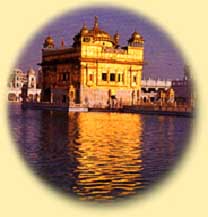
The Sikh symbols are called Panch Piyara and they include the five K's: Kanga or Comb, Kaccha or shorts, Kada or bangle, Kesha or hair and Kirpan or dagger. Every Sikh is supposed to carry these five symbols on his self all the time.
Birth There are no particular rituals connected with the birth of a child in the Sikh community. Some sections of the Sikhs recite the five verses of the Morning Prayer, Japji Sahib into the ears of the newborn child.
Gurthi A respected, intelligent and favorite member of the family gives a drop of honey to the new born child so as togive his characters later in life, to the newborn child. This is not a ritual and it mostly takes place in the hospital itself.
Shushak When a child is born into the Sikh fold, the maternal grandparents gift him a package called Shushak, which consists of clothes for the child and his family, a spoon, glass, and a bowl for the child, money and gold ornaments for the child according to their financial status .
Marriage A Sikh marriage is more or less similar to the Hindu marriage. Here instead of the Vedas the Granth Sahib is read. A Sikh wedding is called Anand Karaj - meaning a ceremony of Bliss. Before the wedding, a three-day wedding path is held and it is one of the main ceremonies. Invitation cards are sent to relatives and friends along with boxes of sweets
Nanke Chak The bride's maternal grandparents and uncle spend a reasonable amount for the wedding of the girl ,like clothes ,jewellery and they also host one meal.
Surma Pawai On the day of marriage, the groom wears a long coat called Brocade Achakan and churidhar pyjamas and a pink turban. The other male members of his family also wear pink turbans. Before leaving for the girls' house , the groom's brother's wife- his Bhabhi applies Surma or Kohl in his eyes. Then the groom leaves his house with a sword on horse back accompanied by friends and relatives in a procession.
Baraat The Baraat arrives at the bride's residence in a procession marked by music, singing and dancing. The male members of the girl's side welcome them.
Milni A poet of the Sikh community sings the Shabad or Holy verse. The two sides exchange garlands. The groom's party is given gifts from the girl's side. After the singing of the holy verse, the couple is made to sit in front of the Granth Sahib. The priest tells the couple about the obligations of marriage and hymns form the Granth Sahib related to marriage areread.
Lawaan The bridegroom leads the bride around the Granth Sahib with both of then holding both ends of a scarf. They go round the holy book four times. At the end of the fourth round, the gathering shower flowers on the couple and they are declared married. The couple is then given gifts by the people and lunch is served. The groom gives silver rings to the sisters of the bride.
Doli Then the groom and the bride leave for the groom's house. The girl throws wheat grains over her shoulders as a mark of paying off her debts to her parental home.
Death In the Sikh community after the death of a person, the Kirtan Solah is read. Loud lamenting and breast -beating are strictly forbidden among the Sikhs. People gather around the body and recite the morning prayers.
The corpse is bathed and dressed along with the fives K's. The Sikhs cremate their dead like the Hindus and they do it before sunset.
The eldest son of the deceased lights the funeral pyre. The priest sings the holy hymns. After the cremation, people go to the Gurudwara where some texts from the Granth Sahib are read. Prasad , is which is cooked with coarsely ground atta, water, sugar and Desi ghee is served to the people.
On the third day after the cremation, the relatives go to the cremation ground, take the bones of the dead and wash them in unboiled milk. Then they collect the bones and the ashes in a bag and immerse it in the Beas River or in the river flowing near their Gurudwara.
They don't observe Shraddh orAnniversary for their dead. The period of mourning for the dead can go up to 10 days, until which the holy texts from the Granth Sahib are read daily in the house.
ZOROASTRIAN RITUALS
Birth
After the birth of a child in a Zoroastrian family, the new mother is normally confined to the house for 40 days. This is to prevent her and her child from any diseases. A lamp is lit on the day of birth and is kept in the room for about 40 days to ward off any evil elements. Some families observe the Pachori on the fifth day while some observe Dasori on the tenth day of the child.On the fortieth day , the new mother is given a ceremonial bath with consecrated water being administered by the head priest. This is done to cleanse her so that she can interact with other people.
Para Haoma The event of giving the first drink to the newborn is called Para Haoma. It is consecrated Haoma juice and it is supposed to make the child healthy. But these days a sweet drink made of molasses or sugar is also administered.
Navjote The formal admission of a child into the Zoroastrian fold is called Navjote. It is done between the seventh and the eleventh year of the child.
First the child takes a special bath called Nahn and then he is given a purifying drink. Then the child stands in a raised platform and his mother performs the Achoo Michoo ceremony where certain items are rotated over the head of the child seven times. This is done to invoke the blessings of the seven Amesha Spentas on the child.
Then certain prescribed texts are read and the Kushti is worn round the waist of the child. Then a long prayer is held when the child declares that he will be a true Zoroastrian and follow the rules and regulations.
Both the Parsi boys and girls are given this privilege. Finally the priest recites the Doa Tandorosoti Prayer, which calls for the well being of the child, his parents and the community in particular.
Marriage The marriage involves the groom going to the bride's house along with his relatives and friends. The priest heads the assembly and women carry the Varni - the gifts meant for the bride. Music bands accompany them.
The bride's house is usually decorated with strings of flowers. When the groom arrives the bride's mother welcomes him by applying Kumkum on his forehead and sprays rice grains over him.
During the ceremony the couple shower rice over each other and the priest also throws rice grains over them as a mark of blessing. A coconut is taken round the head of the groom three times, then it is broken and the water is applied at the feet of the groom. The bridegroom is made to sit on the hand of the bride. Both of them face the eastern direction. One person with a burning flame is allowed to stand near the couple as a reverence to their God of fire. A candle is also placed on both the sides and it burns for the whole ceremony.
The priest gets the consent of the couple and then joins their hands and showers rice grains over them. Then the couple is seated facing each other, with a curtain between them. The couple is made to hold each other's right hand and a piece of cloth is passed round the chairs so as to enclose them. The ends of the cloth are tied symbolizing the marriage knot. Then the writings of the Yatha Ahuvairyo are read.
Finally the curtain is dropped and the couple shower rice grains on each other. The relatives and friends then clap approving the marriage. Then a grand feast is given.
Death
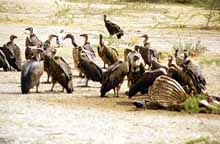
When death of a person is imminent , two head priests are called. They recite the Patet - the prayer for repentance. A few drops of the Haoma juice are administered to the dying person. Nowadays pomegranate juice is also given.
They do not bury or cremate the dead; instead they leave their dead in the "Towers of Silence" where they would be devoured by vultures. This is to ensure that the five elements created by God, are not polluted.


